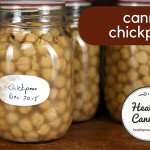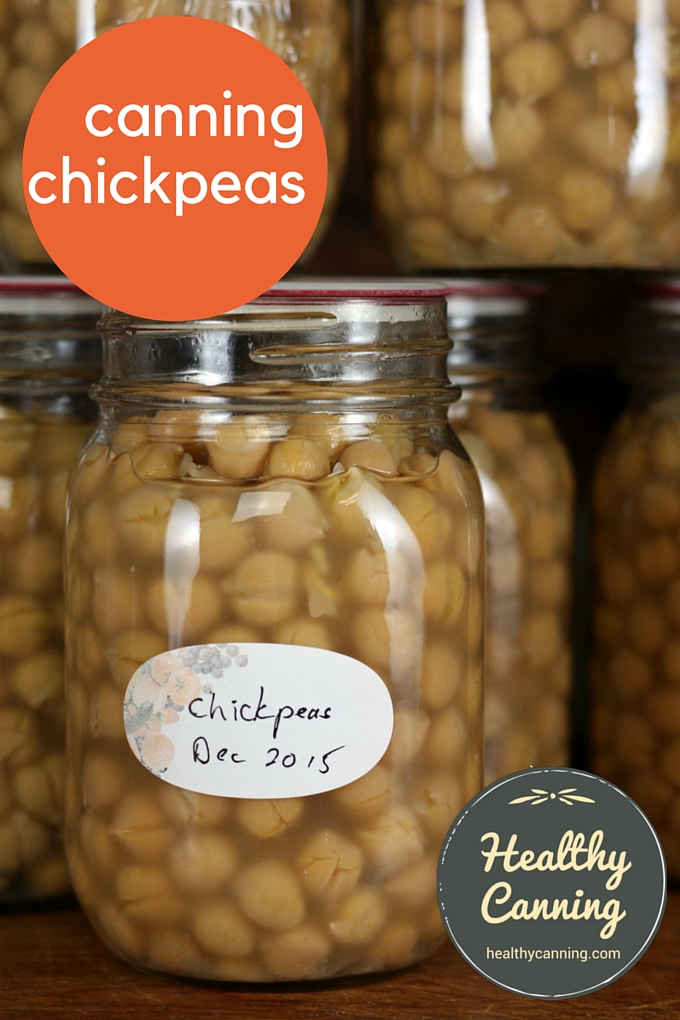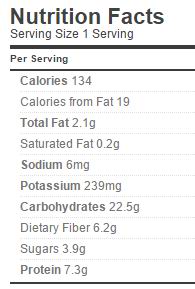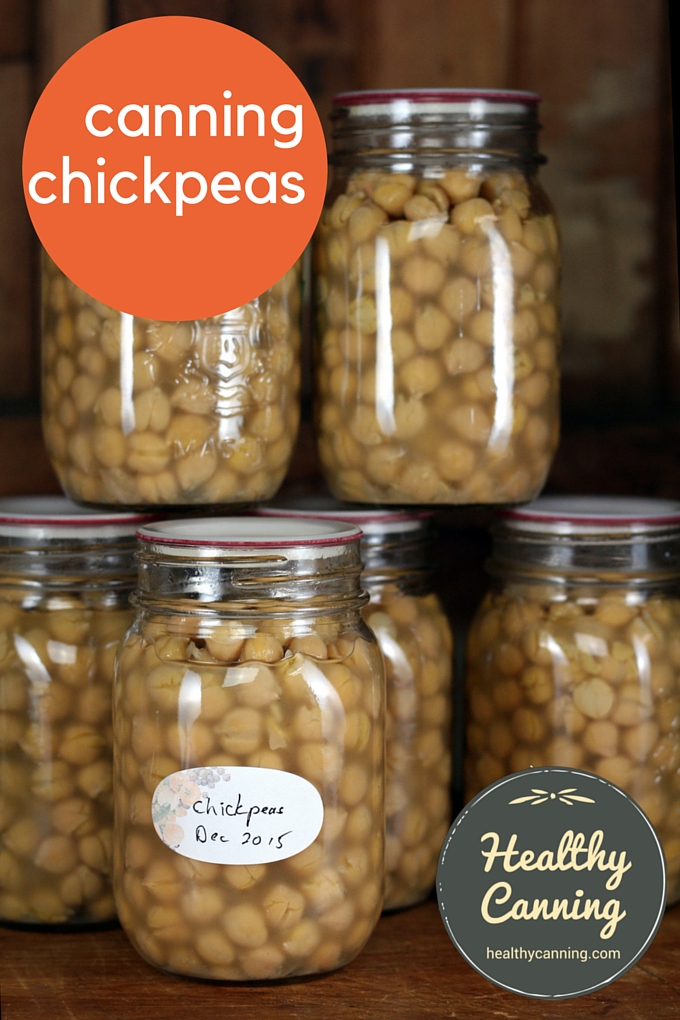Canned chickpeas, ready to use, are really useful to have on hand for making quick dips from, for adding to soups, for garnishing salads, etc.
You can make your own for pennies a jar. They will even taste better than store canned ones, not having that typical tinny taste.
Quantities of dried chickpeas needed
Numbers are approximate guidelines.
- Allow 175 g (6 oz) dried chickpeas per half-litre (US pint) jar. 1.5 kg (3 lbs 6 oz) for a canner load of 9 jars;
- Allow 350 g (¾ lbs) dried chickpeas per litre (US quart) jar.
The recipe
Jar size choices: Quarter-litre (½ US pint) OR half-litre (1 US pint) OR 1 litre (1 US quart)
Processing method: Pressure canning only
Yield: varies
Headspace: 3 cm (1 inch)
Processing pressure: 10 lbs (69 kPa) weighted gauge, 11 lbs (76 kpa) dial gauge (adjust pressure for your altitude when over 300 metres / 1000 feet)
Processing time: Quarter-litres (½ US pint) and half-litres (pints) 75 minutes; litres (quarts) 90 minutes

Canning chickpeas
Instructions
- Either (a) long-soak the dried chickpeas overnight covered with water, OR (b) quick-soak by covering them with water in a saucepan, bring to a boil, boil 2 minutes and let stand for an hour.
- However the beans were soaked, drain and discard the soaking water.
- Put in a pot, cover with fresh water, boil 30 minutes.
- Pack in heated jars: quarter-litre (½ US pint) or half-litre (1 US pint) or 1 litre (US quart)
- If desired, you may add ½ teaspoon of salt per half-litre (1 US pint) jar or 1 teaspoon per 1 litre (US quart) jar (or instead of salt, a non-clouding, non-bitter salt sub)
- Leave 3 cm (1 inch) headspace.
- Top up each jar with clean boiling water (such as from a kettle, for instance) or with the water you just boiled them in, maintaining headspace.
- Debubble; adjust headspace.
- Wipe jar rims.
- Put lids on.
- Processing pressure: 10 lbs (69 kPa) weighted gauge, 11 lbs (76 kpa) dial gauge (adjust pressure for your altitude when over 300 metres / 1000 feet)
- Processing time: quarter-litre (½ US pint) 75 minutes; half-litre (1 US pint) 75 minutes; 1 litre (US quart) 90 minutes.
Nutrition
Processing guidelines below are for weighted-gauge pressure canner. See also if applicable: Dial-gauge pressures.
| Jar Size | Time | 0 to 300 m (0 - 1000 feet) pressure | Above 300 m (1000 ft) pressure | |
|---|---|---|---|---|
| ¼ litre (½ US pint) | 75 mins | 10 lbs | 15 lbs | |
| ½ litre (1 US pint) | 75 mins | 10 lbs | 15 lbs | |
| 1 litre (1 US quart) | 90 mins | 10 lbs | 15 lbs |
Reference information
How to pressure can.
When pressure canning, you must adjust the pressure for your altitude.
More information about Salt-Free Canning in general.
What is the shelf life of home canned goods?
Recipe notes
- The USDA guidelines don’t mention the smaller ¼ litre (½ US pint) size jar, but it’s fine to do so, and it’s really handy to have that 1 cup size for garnishes, salads, etc. It just has to have the same processing time as the next tested size up.
- The beans must be partially rehydrated by the methods described before going into the jars. It is not safe to put dried beans in a jar and fill with water, nor will the quality of the product be good either.
- Canning liquid: The USDA suggests to use the cooking water — the water you cooked in the beans in. So Easy to Preserve (2014, page 86) says instead to use (fresh) boiling water.
- About a day after canning, the water in the jars may all gel solid like refrigerated gravy, so thick you can tip the jars with no movement even. With chickpeas, that is completely normal. For vegans, this thick liquid that results is even desirable: see next point.
- You can use this thick liquid in the jar as an egg substitute in many recipes; it’s referred to as “aquafaba.” The recommendation is 2 tbsp to substitute for an egg white; 3 tbsp for a whole egg.
Recipe source
Beans or Peas – Shelled, Dried: All Varieties. In: United States Department of Agriculture (USDA). Complete guide to home canning. Agriculture information bulletin No. 539. 2015. Page 4-5.
Modifications: none
Nutrition
Per ½ cup / 130 g:
- 112 calories, 1 mg sodium
- Weight Watchers PointsPlus®: ½ cup / 130 g = 3 points; 1 cup / 225 g = 6 points
* Nutrition info provided by https://caloriecount.about.com
* PointsPlus™ calculated by healthycanning.com. Not endorsed by Weight Watchers® International, Inc, which is the owner of the PointsPlus® registered trademark.
Cooking with canning
Fried chickpeas from home canning
Saag Paneer with chickpeas and okra




Julia
Would it be safe to add some flavouring like herbs or garlic to the jars?
Patty
My first time canning I forgot to leave one inch space is that bad ?
Healthy Canning
Canning recipes are meant to be followed as written. Without the headspace to provide a vacuum, the seals on your jars may not last long. Time will tell.
Lisa
Can I use fresh chickpeas that I shelled and have in my freezer?
Healthy Canning
Hi Lisa, ask one of these Master Food Preserver groups what they feel.
Ashley N Zumstein
If you take out the aquafaba from the chickpeas can you can the drained chickpeas in fresh water?
Healthy Canning
Hi Ashley, I’m not tracking. The canning directions are “Top up each jar with clean boiling water (such as from a kettle, for instance) or with the water you just boiled them in, maintaining headspace.” So Easy To Preserve suggests the clean water; USDA guide suggests the cooking liquid.
David
I think what Ashley is saying is, if you take commercially canned chickpeas, drain their liquid (this is called aquafaba) can you then take the remaining chickpeas and recan them at home using fresh water.
The thick liquid found in commercially canned chickpeas (ie aquafaba) is often used as an egg substitute by vegans or other people who either do not use or, alternatively, do not have access to eggs.
Healthy Canning
Oh right, thanks David! The National Center recommends against recanning items, as the texture and density of canned items will not match that on which they based their recommendations. (The one exception we can think of is canned tomatoes – they are often drawn on as an ingredient in canning recipes.)